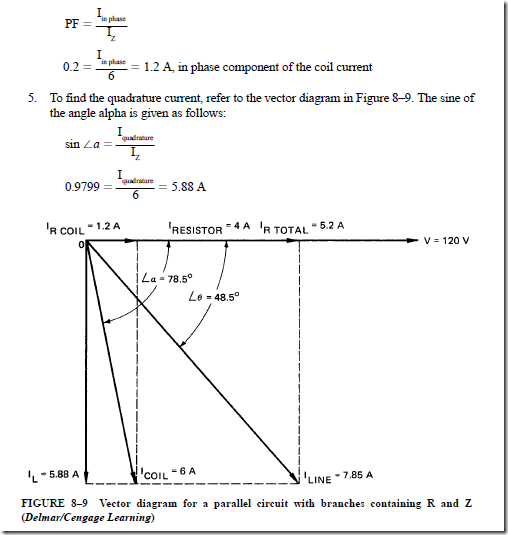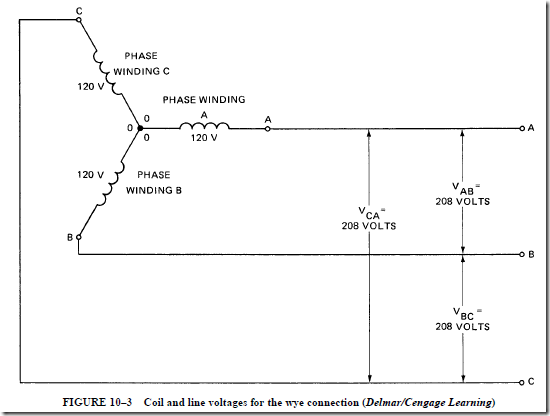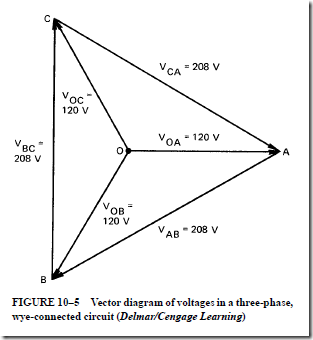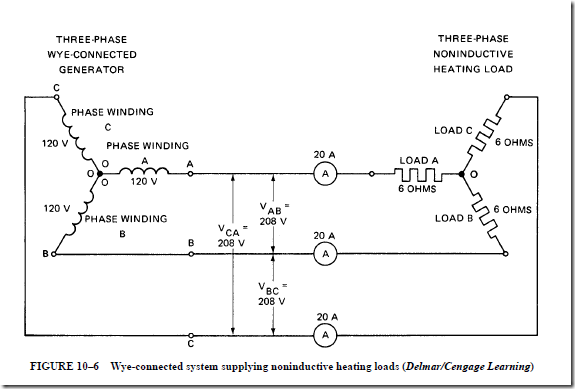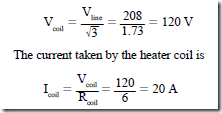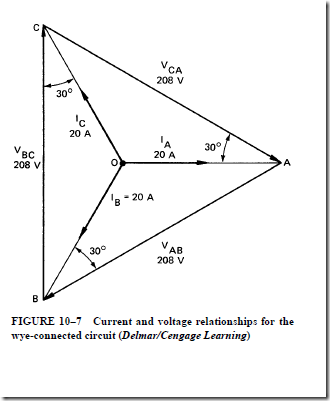AC Instruments and Meters
MEASUREMENT OF AC QUANTITIES
The equipment used to measure ac quantities differs somewhat from the equipment used in dc measurements. This unit will describe the instruments generally used to mea- sure voltage, power factor, VARs, current, watts, frequency, and phase angle. In addition, meters will be described for measuring watt-hours, Watt-hour demand, varhours, and varhour demand.
For the instruments used to measure ac voltage, current, watts, and VARs, each movement must have three basic components:
1. A spring mechanism to produce an opposing torque; the magnitude of this torque depends on the quantity being measured.
2. A restoring spring mechanism to restore the indicator or pointer of the meter to zero after the required measurement is made. In practice, one mechanism is used to pro- duce the opposing torque and then return the indicator to zero.
3. A damping system to prevent the pointer from overshooting and excessive swinging.
If too much damping is provided, a long time is required before the pointer can reach a new reading after a change occurs in the measured quantity. The proper damping means that the pointer moves quickly and stabilizes quickly when the quantity being measured is changed. AC instruments often use electromagnetic damping. As shown in Figure 11–1, a permanent magnet induces eddy currents in some part of the instrument movement. The magnetic effect of these eddy currents opposes the motion of the pointer. Air damping is another method of controlling the motion of the pointer. In this method, a vane retards the movement of the pointer.
MEASUREMENT OF VOLTAGE AND CURRENT
Alternating current and voltage can be measured using several different types of movements. These movements vary in their ability to meet the criteria expressed in the following questions:
1. Does the instrument scale indicate RMS or average values?
2. To what value of volts or amperes must the movement respond?
3. Is the calibration of the scale linear in the useful range, or are the numbers on the scale crowded together in some important region?
4. How accurate is the instrument?
5. How much does it cost?
RECTIFIER INSTRUMENTS WITH D’ARSONVAL MOVEMENT
Direct Current Fundamentals described the d’Arsonval dc instrument movement. This movement can be used for ac measurement if a rectifier is also used.
Figure 11–2 shows a bridge-connected full-wave rectifier used with a voltmeter. (R is the series resistor normally required with a voltmeter.)
The dc d’Arsonval movement develops a torque that is proportional to the average value of the current in the moving coil. For an ac wave, only the RMS (effective) values are of interest. Thus, the ac scale is calibrated in RMS values. The RMS voltage is 1.11 times the average voltage value of a sine wave. This means that rectifier-type measuring instruments are accurate only when pure sine-wave quantities are involved. If the voltage to be measured has another type of wave shape, the instrument will give erroneous readings.
Multimeters are instruments that measure both ac and dc quantities. d’Arsonval move- ments are used in most multimeters. When used as a voltmeter, a multimeter is expected to have a high resistance linear scale and consume relatively little power. When used as an ammeter, most rectifier-type multimeters must be used in the range of microamperes or milliamperes. The full-scale readings will range from about 100 µA to 1000 mA. A multi- meter with a d’Arsonval movement is shown in Figure 11–3.
OTHER TYPES OF AC VOLTMETER AND AMMETER MOVEMENTS
Several other types of ac movements can be used in measuring instruments. These movements include the following:
• Magnetic vane attraction movement
• Inclined coil movement
• Repulsion movement
• Repulsion–attraction movement
• Dynamometer movement
All of the movements listed respond to RMS values of voltage or current.
The Magnetic Vane Attraction Movement
This type of movement has a soft iron plunger that projects into a stationary field coil (Figure 11–4). Current in the field coil produces a magnetic force that pulls the plunger deeper into the coil. The instantaneous value of this magnetic force is proportional to the square of the current in the coil. This means that the average torque turning the movement is proportional to the average, or mean, of the squares of the coil current (the RMS values).
This torque is independent of current direction. Thus, the instrument can be used for either ac or dc measurements.
The magnetic force that attracts the plunger has a minimum value when the plunger is just entering the coil. The value of the force increases rapidly as more of the soft iron vane enters the coil. This means that the numbers are crowded together at the lower end of the scale and are expanded for the high end of the scale. This type of movement is commonly used in low-cost ammeters. When a coil of many turns and a series resistor are added, this movement can be used to make voltage measurements.
Inclined Coil Movement
The Thompson inclined coil movement (Figure 11–5) is used in portable and switch- board ammeters and voltmeters. The scale of this movement is long and reasonably linear. An iron vane is free to move in a magnetic field. The vane tends to take a position parallel to the flux. Figure 11–5 shows a pair of elliptical iron vanes attached to a shaft passing through the center of the stationary field coil. If the current in the field coil is increased, an increasing force is produced, which tends to align the vanes with (parallel to) the coil flux. As a result, the shaft turns and moves the attached pointer across the scale.
Repulsion Movement
The repulsion-type movement can be used for both current and voltage measure- ments. A repulsion force is developed between two soft iron vanes that are affected by the same magnetic field (Figure 11–6). One iron vane is attached to the instrument shaft.
The other vane is mounted on the stationary field coil. When there is no current in the coil, the control spring holds the movable vane close to the fixed vane. Alternating current in the field coil magnetizes both vanes. The like poles of the vanes repel each other and create a torque. This torque turns the instrument shaft. The repulsion force between the two vanes varies according to the square of the current. This force also varies inversely as the square of the distance between the vanes. As a result, the movement has a reasonably uniform scale.
The Repulsion–Attraction Movement (Figure 11–7)
This type of movement is used for both ammeters and voltmeters. It produces more torque per watt than do any of the other ac movements included in this list. A cutaway view of the structure of the repulsion–attraction movement is shown in Figure 11–7.
The instantaneous polarities of the iron vanes are shown in Figure 11–8. The movable vane is repelled from the wide end of the middle fixed vane first. The repelling force decreases as the vane moves to the narrow end of the middle vane. An attracting force increases as the ends of the moving vane come closer to the upper and lower fixed attraction vanes. When these fixed attraction vanes have the correct size and spacing, a scale length representing 250° of angular deflection can be provided. The distribution of values along the scale is determined by the shape and separation of the vanes. Meters can be designed to broaden the scale at any point.
Dynamometer Movement
The dynamometer movement produces a torque by the interaction of magnetic fields. One field is caused by the current in a moving coil. A second field is due to the current in a stationary coil. This stationary magnetic field is not constant. It varies with the amount
of current in the stationary coils. Thus, the torque produced in this movement depends on the moving coil current and the stationary coil current. The fixed and moving coils are connected in series. The dynamometer movement can be adapted easily to make voltage measurements by adding the proper series resistor.
Figure 11–9 shows a dynamometer movement used as a voltmeter. When compared with d’Arsonval movements, the dynamometer movement is more efficient and accurate (to one-quarter of 1% or better). This type of movement is seldom used as an ammeter for the following reasons: (1) the lead-in spirals to the moving coil can carry a limited current only, (2) frequency variations influence the inductance of the coils and introduce error, and
(1) the resistance of the two coils in series may produce an undesirably high voltage drop across the shunt.
The torque is determined by changes in the stationary coil current or the movable coil current. Because of this fact, the dynamometer movement is a very useful measuring device for several other applications. Although this type of movement may be used for dc, most of its practical uses are for ac. For example, instruments with dynamometer movements are used to measure power in watts and reactive volt-amperes. Such instruments are also used to measure power factor and frequency and to indicate synchronism in ac circuits.



















































